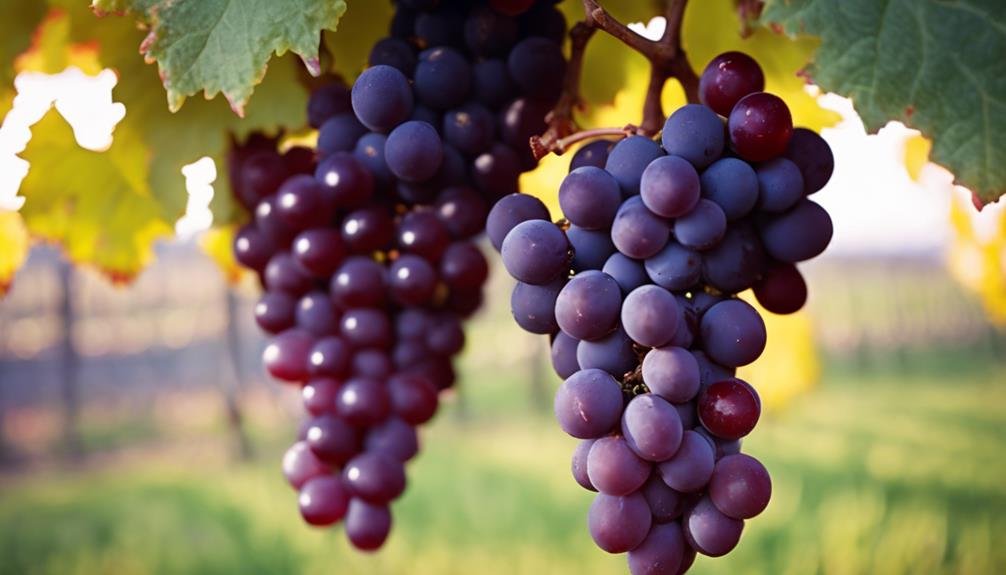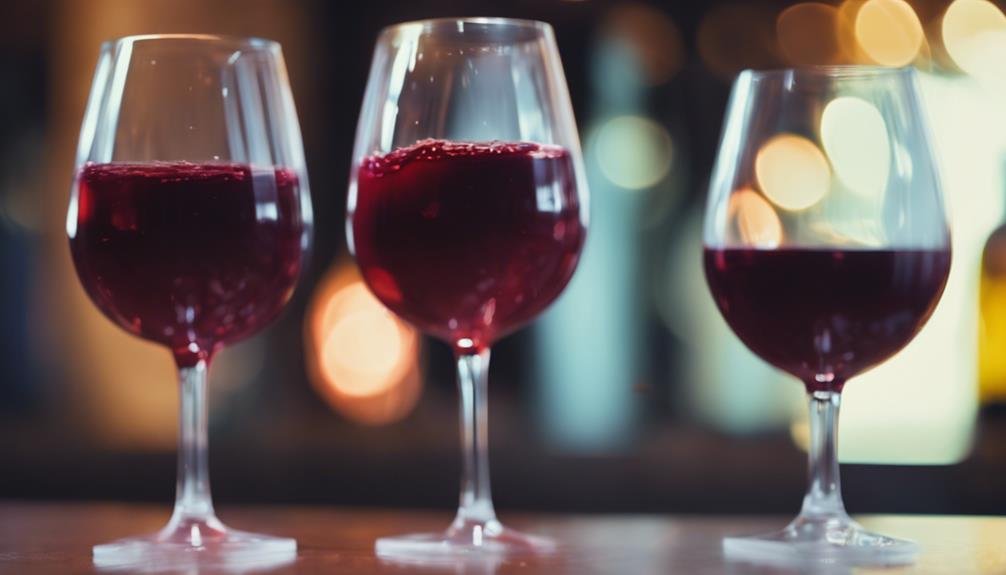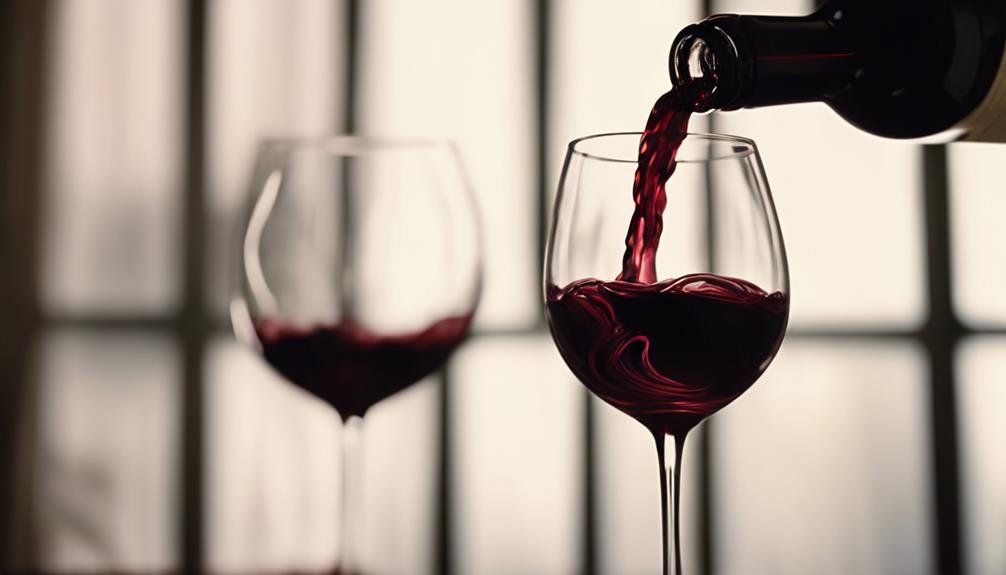Discover the vibrant color secrets of red wine by understanding anthocyanins, pH levels, grape varieties, opacity, and aging effects. Anthocyanins from grapes like Cabernet Franc create the rich hues, influenced by extraction methods like cold soaking. pH plays an essential role, affecting color vibrancy, with lower levels producing red hues. Different grape varieties offer unique color characteristics shaped by factors like terroir. Opacity and color intensity reflect wine quality, affected by aging processes that lead to a shift in hue from intense red to garnet. Unraveling these elements reveals the mesmerizing journey from grape to glass, offering insights into red wine's alluring appeal.
Anthocyanin: Red Wines Color Origin
The vital color of red wines is primarily attributed to the presence of anthocyanin, a pigment found in various sources such as Cabernet Franc grapes, blackberries, and hibiscus flowers. Anthocyanin extraction techniques vary, with methods like cold soaking, extended maceration, and fermentation on the skins being common in winemaking.
Factors affecting anthocyanin stability include pH levels, temperature, oxygen exposure, and sulfur dioxide additions. Maintaining proper conditions during winemaking and storage is essential to preserve the rich red hues derived from anthocyanin.
Understanding these extraction techniques and stability factors is important for winemakers aiming to produce wines with consistent and appealing color profiles. By controlling these aspects, winemakers can enhance the visual appeal and overall quality of red wines.
Ph Influence on Red Hue
Influencing the red hue of red wine, pH levels play an essential role in determining the color spectrum displayed in the glass. The pH balance, or acidity, directly impacts the color vibrancy and visual appeal of red wines. A lower pH, indicating higher acidity, typically results in a red hue.
On the other hand, a violet hue is often associated with a pH range around 3.4–3.6, while a blueish tint suggests lower acidity with a pH possibly close to 4. Different grape varieties exhibit distinct color characteristics based on their pH levels.
Understanding the relationship between pH balance and red wine hue can provide valuable insights into the wine's overall quality and flavor profile.
Grape Varieties and Color Expression

Understanding the diverse range of grape varieties is essential in unraveling the intricate tapestry of color expression in red wines.
- Color genetics: Different grape varieties contain varying levels of anthocyanin, influencing the color palette of red wines.
- Environmental influences: Factors like climate, soil composition, and vineyard location can impact the color intensity and hue of red wines.
- Grape variety selection: Winemakers carefully choose grape varieties based on their color characteristics to achieve desired hues and intensities in the final product.
- Anthocyanin levels: Grape varieties with higher anthocyanin content tend to produce deeper and richer red wine colors.
- Terroir effects: The unique terroir of each vineyard plays an important role in shaping the color expression of red wines, making each bottle a reflection of its origin.
Opacity and Color Intensity
Investigating the interplay between opacity and color intensity reveals the concealed intricacies of red wine's visual allure. The opacity of wine, determined by its color intensity, is a key indicator of its pigment and phenolic content.
Opaque wines, rich in pigments like anthocyanins, often exhibit deeper and more vibrant colors. Light exposure effects can alter this intensity over time, affecting the wine's overall appearance.
Decanting benefits can help enhance color intensity by introducing oxygen, allowing the wine to open up and reveal its true hues. Understanding how these factors influence the opacity and color intensity of red wine can provide valuable insights into its quality and potential for aging.
Aging Effects on Red Wine Color

The evolution of red wine's color profile undergoes significant transformations as it ages, reflecting alterations in pigment composition and intensity levels.
- Color stability: Red wines can lose vibrancy and shift towards a more brick-like color with age.
- Pigment degradation: Anthocyanins break down over time, leading to a lighter appearance in older wines.
- Hue changes: Young wines may display intense red or purple hues that fade to garnet or amber tones as they mature.
- Intensity reduction: Aging can result in a decrease in color intensity due to the breakdown of pigments and phenolic compounds.
- Tannin influence: Tannins can also play a role in the color evolution of red wines, contributing to changes in hue and intensity over time.
Frequently Asked Questions
How Does the Presence of Anthocyanin Affect the Taste of Red Wine?
Anthocyanin concentration in red wine greatly influences its flavor profile. The presence of anthocyanin, extracted during fermentation, contributes to the wine's color intensity and potential health benefits. These compounds enhance the wine's sensory experience.
Can Ph Levels in Red Wine Be Altered to Change Its Hue?
Adjusting acidity in red wine can subtly shift its hue, offering a palette of colors from vibrant reds to deep blues. Enhancing color through pH manipulation showcases the intricate dance of science and artistry in winemaking.
Are There Specific Grape Varieties Known for Producing Exceptionally Intense Red Wine Colors?
Certain grape varietals like Petit Verdot, Sagrantino, and Alicante Bouschet are renowned for producing intensely colored red wines. Their high levels of anthocyanin contribute to rich hues, enhancing the wine's flavor profile and visual appeal.
Does the Opacity of Red Wine Indicate Its Quality or Age?
The opacity of red wine does not directly indicate its quality or age. Opacity levels can reflect color intensity, influenced by grape variety, tannins, and aging. Vibrancy and color depth often showcase wine characteristics more than mere opacity.
How Do Different Aging Processes Impact the Color of Red Wine Over Time?
Different aging processes, particularly oak aging, influence the color stability of red wine over time. Oak barrels can impart hues and intensify tones, affecting the wine's overall appearance. Understanding these impacts enhances appreciation and evaluation of wine quality.
Conclusion
In the colorful tapestry of red wine, the mysteries of its vibrant hues lie in the intricate dance of anthocyanin, acidity, and aging. Like a master painter creating a masterpiece, each varietal reveals a unique story through its rich crimson to violet shades.
These hues, influenced by tannins and temperature, offer a glimpse into the wine's origin and aging potential. Revealing the secrets of red wine's colors exposes a world of artistry and complexity waiting to be explored.
